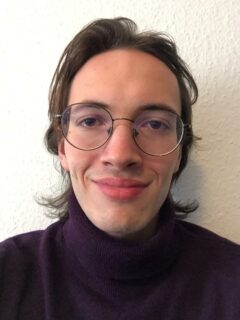Julius Glaser
Julius Glaser
Thesis Topic: Variational autoencoder for diffusion weighted imaging
Supervisors: Zhengguo Tan, Frederik Laun, Florian Knoll
Description
The overall goal of the thesis is to implement a variational autoencoder (VAE) [1] for enhanced reconstruction of diffusion weighted MR images. Diffusion-weighted imaging (DWI) faces several technical challenges, one of which is the inherent low signal-to-noise ratio. Therefore, the denoising of the images is a crucial task to increase the read- and interpretability of DWI. In this work, an approach using a variational autoencoder for DWI denoising and reconstruction shall be explored.
Autoencoders are a deep-learning network, which decreases the input space to a latent space in of less size in the encoder part and scale it up again to the input resolution in the decoder part. The aim of the autoencoder is to learn a sparse representation of the input. In variational autoencoders the learned latent space are no specific values, but distributions with certain mean and variance from which samples are drawn and used in the decoder.
The VAE for denoising is trained by using a dictionary of simulated signals using biophysical modeling with added noise and trained to denoise these signals, because no in-vivo ground truth data is available. Using this VAE, multiple possibilities exist for a denoised reconstruction of acquired DWI k-space data using a VAE and shall be explored in the thesis:
- Reconstruction of the raw data using a well-known reconstruction technique like MUSE [2] and using the VAE afterwards for denoising of the recon-structed signal.
- Using the decoder of the VAE in the reconstruction model to decrease the number of parameters that have to be reconstructed, which was used by Arefeen et al. for T2 weighted signals in [3]
- Using the VAE as a regularizer for the iterative MUSE reconstruction like it was shown for DWI and a usual Autoencoder by Mani et al. [4].
The performance of the approaches using the VAE shall also be compared to a not deep learning, but SVD based latent space reduction. Addditionally the VAE dictionary shall be expanded from only a pure DTI learning to be trainable for a ball-and-stick model [5] approach as well.
[1] Diederik P Kingma and Max Welling. Auto-encoding variational bayes, 2022.
[2] Nan-Kuei Chen, Arnaud Guidon, Hing-Chiu Chang, and Allen W Song. A robust multi-shot scan strategy for high-resolution diffusion weighted MRI enabled by multiplexed sensitivity-encoding (MUSE). NeuroImage, 72:41-47, 2013. doi: 10.1016/j.neuroimage.2013.01.038.
[3] Yamin Arefeen, Junshen Xu, Molin Zhang, Zijing Dong, Fuyixue Wang, Jacob White, Berkin Bilgic, and Elfar Adalsteinsson. Latent signal models: Learning compact representations of signal evolution for improved time-resolved, multi-contrast mri. Magnetic Resonance in Medicine, 90(2):483–501, 2023. doi: https://doi.org/10.1002/mrm.29657.
[4] Merry Mani, Vincent A. Magnotta, and Mathews Jacob. qmodel: A plug-and-play model-based reconstruction for highly accelerated multi-shot diffusion mri using learned priors. Magnetic Resonance in Medicine, 86(2):835–851, 2021. doi: https://doi.org/10.1002/mrm.28756.
[5] T.E.J. Behrens, H. Johansen Berg, S. Jbabdi, M.F.S. Rushworth, and M.W. Woolrich. Probabilistic diffusion tractography with multiple fibre orientations: What can we gain? NeuroImage, 34(1):144–155, 2007. ISSN 1053-8119. doi: https://doi.org/10.1016/j.neuroimage.2006.09.018.
